Thailand | Thammasat University
BY RACHEL TANG

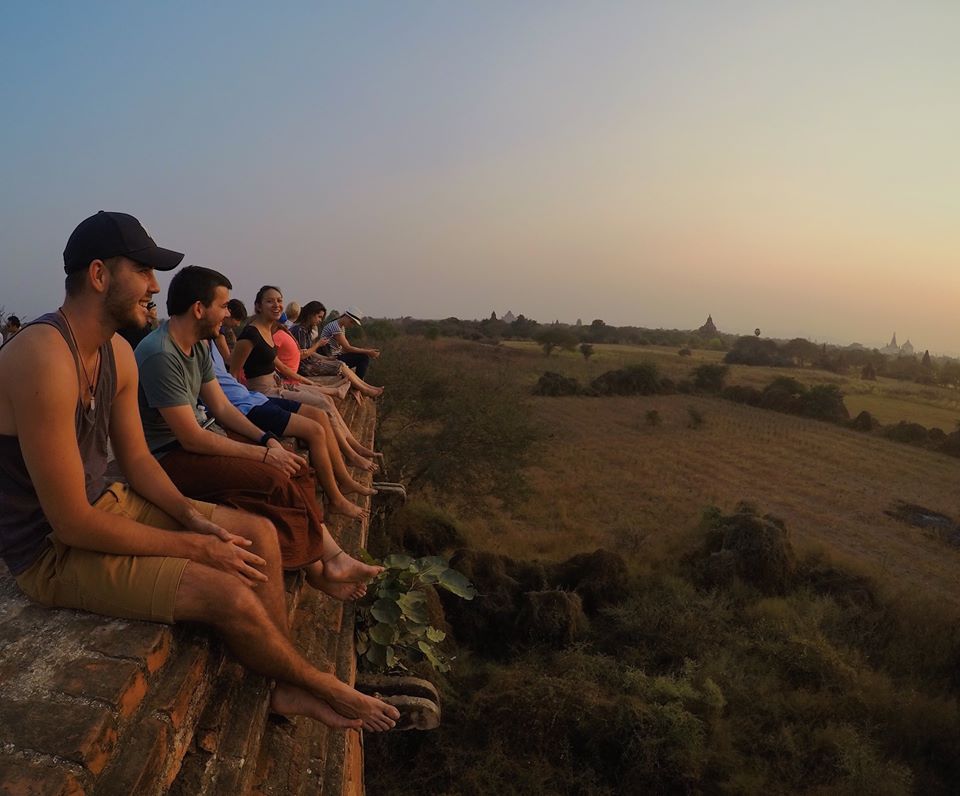
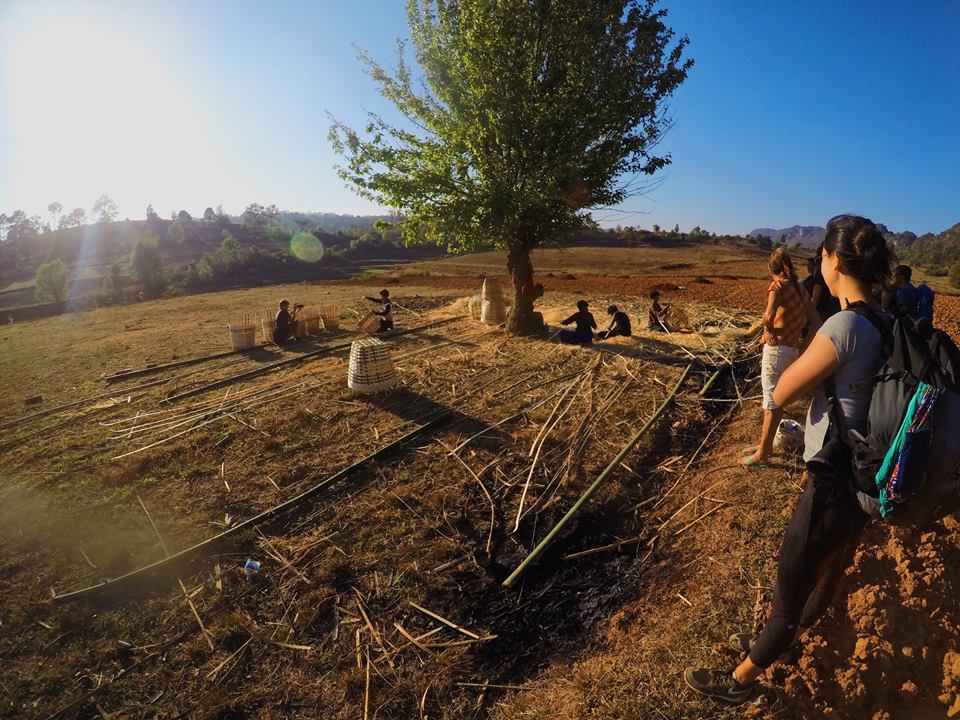
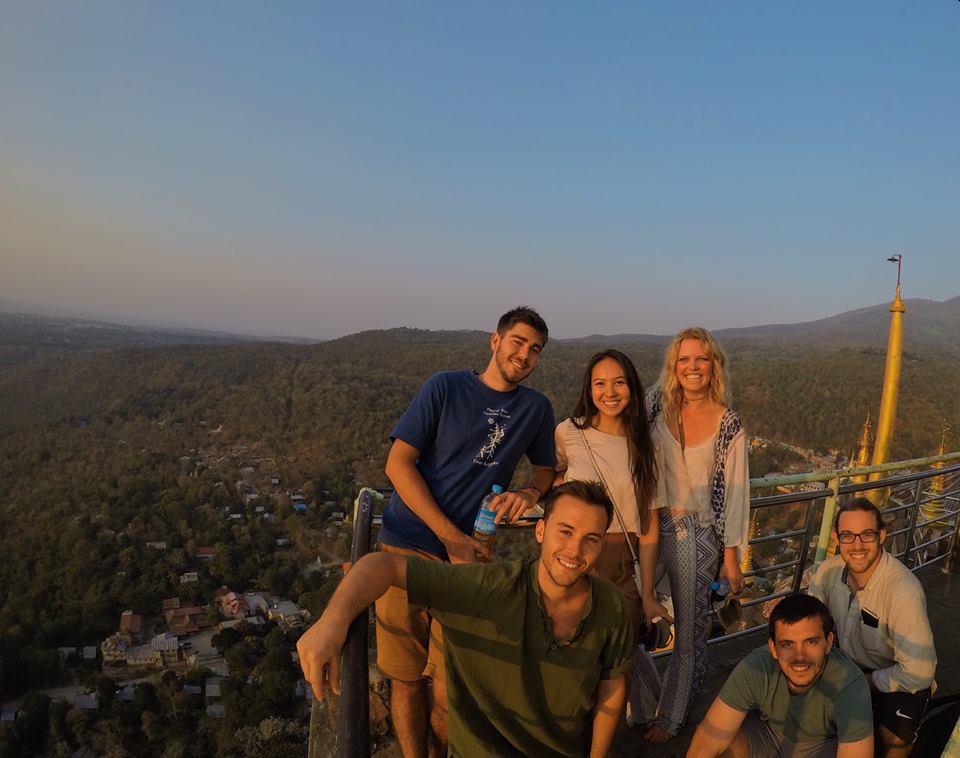
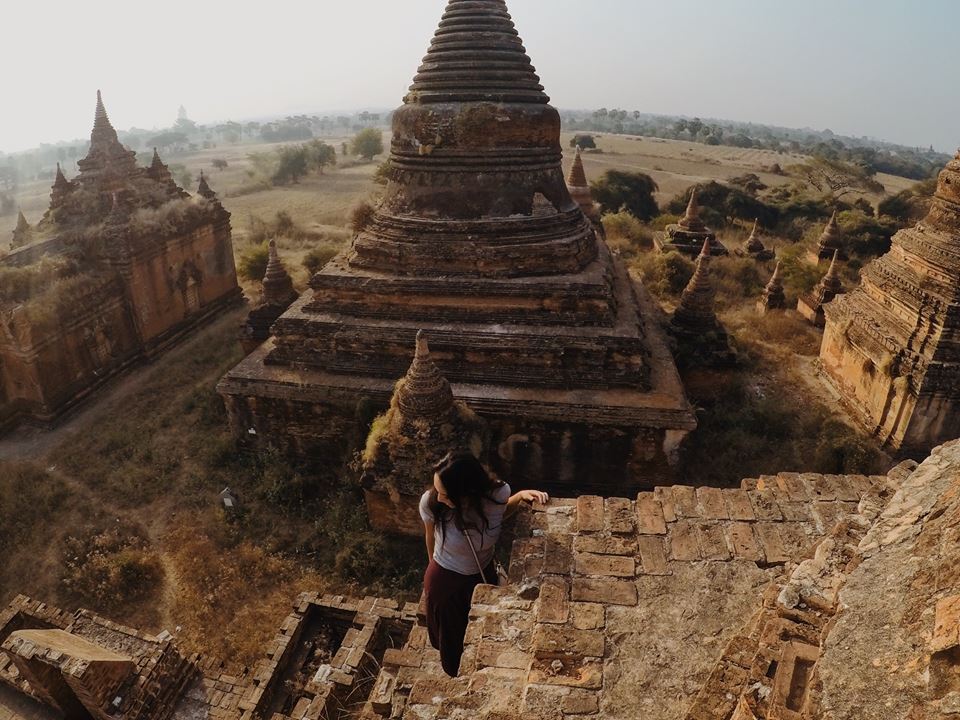
Rachel Tang studied abroad in Bangkok, Thailand, in spring 2017: http://eap.ucop.edu/OurPrograms/thailand/Pages/thammasat_univ.aspx
BY RACHEL TANG





Rachel Tang studied abroad in Bangkok, Thailand, in spring 2017: http://eap.ucop.edu/OurPrograms/thailand/Pages/thammasat_univ.aspx
BY BARRY YANG
US & LYON
After having spent nearly 3 months in France, I have gotten a pretty good handle on the sequences of French living and can clearly see and feel salient differences between the land of Francois and Donald.
I have talked about the French education system before. However, after three months, I have had a chance to experience all my classes and establish a more thorough and informed opinion. I am currently taking six classes this semester: five political science classes and one French language and culture class. Two of these classes do not last the whole semester and only run for six weeks at four hours per week. Only four of my classes actually run the length of the semester. I do not know if it is just because we are international students, but the classes also all end at different times; some end a week earlier and some 2 weeks later. The class sizes are also are very small. With the exception of the BREXIT class, every other single class is never more than about twenty students. One of the most forward differences between classes in Lyon and in the US are the final exams. Besides not really assigning any homework or readings, professors tend to ask students their opinion on the final exam and some will even make amendments to the exam depending on popular opinion. My finals for all my classes range from presentations to short in class essay and short take home papers. There is even one class that let us come up with our essay question for the final. The latitude in these classes is both good and bad.
While the relatively low workload allows many of us to travel more easily, the lack of work and structure at times detract from the education and sometimes I feel that there is more we could have learned. However, this is my first time in Europe and I am traveling all over the place so I really have no complaints.

In the states we are all use to bigger college campus that resemble small towns more than institutions. However, in Lyon, many of the universities and grade schools are just one building and not really campuses. There are not really dedicated places for students to eat (at least for those who brought their own food), there is no public gym, and the libraries are relatively small. However, these schools have much less students than the typical UC, so the infrastructure does not need to be as big. The university is also very integrated into the city. Instead of hanging around on “campus” after classes, students just wander into the city and lounge around in coffeeshops and small restaurants. This is a pretty good phenomenon as there are plenty of student friendly establishments that offer some great deals. There is a burger place that offers killer deals on Mondays and Thursdays where you can deluxe customized burgers for four euros.

Speaking of euros; living in Lyon is comparable to the US. Food, that is not fast food or kebabs, run around 12-14 euros a person. The portion sizes are very small and hardly filling. More authentic Lyonnais restaurants or “Bouchon” run upwards of 30 euros per person. Fruits and vegetables are more expensive than in the states and there is less variety. The thing that makes living in Lyon more expensive than the states is the inconvenience of making your own food. Living in a host family is nice, but only breakfast and dinner are provided and only during the weekdays. This leaves 11 meals that we have to figure out on our own. Most of the time we resort to eating out simply because it’s difficult to cook in our host families’ homes. For me personally, the time I get home is also usually around the time my host mom is cooking dinner and I do not want to be a bother and take up space in the kitchen cooking my own food for tomorrow. However, if you really wanted to, it is possible to cook your own meals. It is definitely not as easy as when living on your own or with your personal family. The inconvenience and low key awkwardness of cooking your personal food in someone else’s home helps induce a laziness to not make your own food.

The cars in Lyon are a lot smaller than those in the US, and so are the roads. People tend to kind of just weave through traffic and its hard to decipher whether traffic signs are actual legal signage or merely suggestions. Last weekend we took a ride in a BlaBlaCar (ride sharing service in France) and many drivers on the freeways were essentially tailgating each other and no one really signaled until the moment right before he or she changed lanes. The lanes are also very narrow and when you pass another car you get a real good look at the other drivers. My girlfriend and I are contemplating renting a car this weekend to explore the countryside surround Lyon. However, given the countless one way streets, turnarounds, and obscure traffic signs, I am a little hesitant as crashing a French car sounds incredibly unpleasant and I would really not like to get in any arguments with French drivers…I hear three day old baguettes hurt.
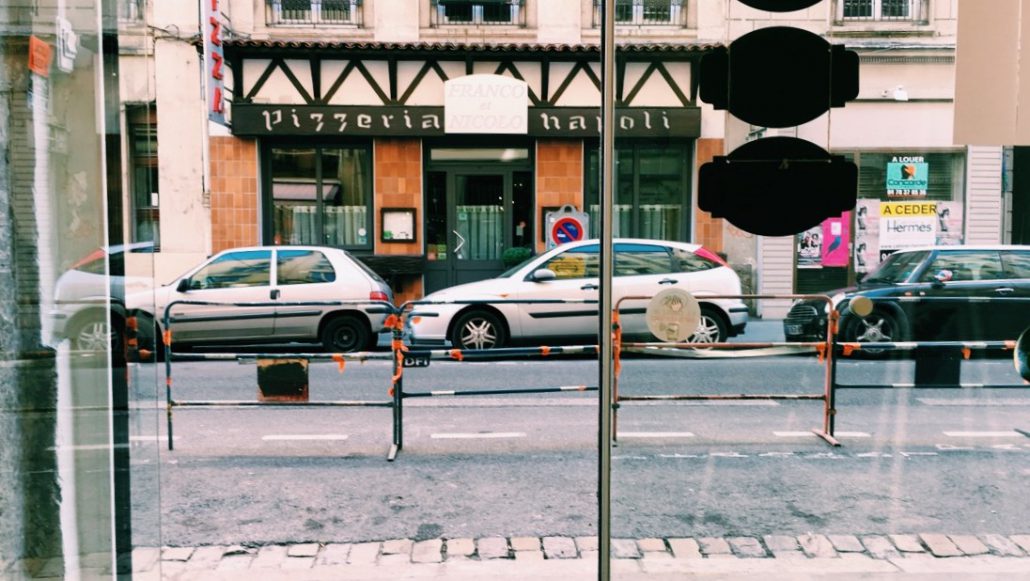
Barry Yang studied abroad in Lyon, France, in Spring 2017: http://eap.ucop.edu/OurPrograms/france/Pages/default.asp
BY MONICA MARTINEZ
A Little Recap
Hello friends! In case you missed the latest weather report, Cyclone Debbie hit northern Queensland this past week. TC Debbie made landfall approximately 800 miles north of Brisbane in Airline Beach as a category 4 storm on March 28th. Although the storm weakened, ex-TC Debbie caused significant damage to South East Queensland and north New South Wales. On March 30th, I received a text alert warning of severe weather in Brisbane and a message from the UQ Chancellor cancelling all classes for the day. Given the distance from the origin of the storm and Brisbane, I foolishly thought the precautions were a little exaggerated. But boy, I WAS WRONG. From 6am to approximately 11pm, Brisbane was consumed by 9 inches of rain, flash floods, and destructive wind gusts up to 62 mph. Luckily, no significant damage was reported in Brisbane and March 31st brought a new, safer day. To say this was something I had never experienced before would be an understatement and it definitely adds to a long list of memories I will keep of my time abroad.
Mini Getaway
It is currently Week 5 at UQ, otherwise known as the week where classes start getting harder because you have (almost) reached the half way point in the semester. To get rid of stress, I took a one-day trip with friends from the UQ Latin American Society to Lone Pine Koala Sanctuary in Fig Tree Pocket, Queensland. If you take the bus from UQ to Lone Pine Koala Sanctuary, the stop will leave you right in front of the entrance (the ride costs $1.28 and is approximately 43 minutes). At the entrance, I showed the clerk my UQ student ID to purchase an entry ticket at the student/concession price. A major note to anyone studying in Brisbane: you can receive a student discount on almost everything by showing your student ID – this applies to sporting events, theatres, museums, and amusement parks to name a few. Take advantage of this to save a few extra $ when exploring!

As I entered the park, I could not contain my excitement. At every corner, large enclosures contained heaps of Australia’s native marsupial: the koala! I had visited zoos before, but I had never seen a koala in real life, let alone one inches away from me. Most of the koalas were either fast asleep, eating eucalyptus leaves, or moving leisurely from branch to branch. A sign next to the enclosure read “Take a photo with a koala, today!” and I was more than ready for the opportunity as it was one of my biggest Australian dreams. While in line to purchase a voucher to take a picture with a koala, a kind local gave me a free pass (further convincing me that Australians are the kindest people on the planet).

After waiting for approximately 12 minutes in line, I got to hold my new best friend Guppy. The handler instructed me to cup my hands in front of me and remain still before casually placing Guppy on me. He felt soft, light, and had a distinct smell of mint (so strange, I know). Although the encounter lasted less than three minutes, it truly was one of the greatest moments of my life. Before moving on to the other animal enclosures, I collected my photo souvenir from the “Wall of Fame” among the likes of Nicki Minaj, Serena Williams, and President Ronald Reagan.
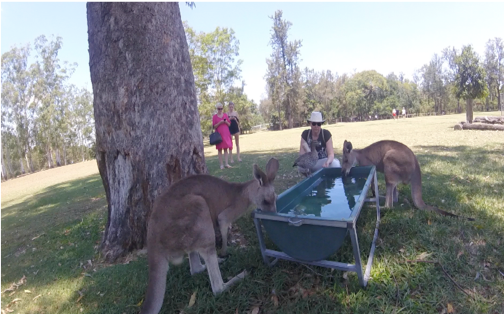
Next to the koala encounter was the Kangaroo Reserve – a large park filled with free-range kangaroos, wallabies, and ostriches. I purchase a small bag of kangaroo food for $2 from the convenience store and nervously entered the area. With each step, I noticed how massive the reserve was. Kangaroos were all over the field, either hopping freely from tree to tree or laying down, waiting for the next visitor to offer food or a nice rub. I anxiously approached a female kangaroo (noticing her enlarged pouch), stuck out a handful of food, and waited for her to react. As the kangaroo came to me and ate food from my hand, I turned to my friend with my jaw dropped. While I had seen kangaroos before in zoos, I had never been this close to one nor had I had the opportunity to feed one. The gums of the kangaroo (who I nicknamed Sophie) tickled my hand as she ate and I could not help but laugh uncontrollably. As Sophie ate, I extended my spare arm and brushed her fur (way smoother than I expected). One of the wildest things that happened while I fed Sophie was witnessing a kangaroo fight. Not only was seeing two male kangaroos stand up and position themselves like boxers utterly amazing, but I heard them bark. There is no exaggeration when I say these kangaroos barked exactly like dogs.

After running out of food to feed the kangaroos, the group explored the platypus, Tasmanian devil, and dingo exhibits. To end the night, the group opted to take advantage of the sanctuary’s free entertainment night. Finding Dory was shown on the picnic area and a food truck market was in full force in the parking lot. From German to Italian food, the options were endless. Although the trip lasted a few hours, I loved getting to check holding a koala and feeding a kangaroo off my bucket list!
The 411
Although it has been over a month since arriving in Australia, I am still getting used to the lingo. Here is your everyday guide into Australian slang:
Aboriginal = Indigineous people of Australia
Arvo = Afternoon
Bathers/Swimmers = Swimsuit
Cheers = Thanks/Goodluck
Course = Class
Exy = Expensive
Footy = Australian football game
G’Day = Hello
Good on ya = Well done
Heaps = A lot
How ya going? = How are you?
Hungry Jacks = Burger King
Keen = Interested
Lippie = Lipstick
Lollies = Candy
Macaas = McDonalds
Mate = Friend
Snag = Sausage
Thongs = Sandals
*Bonus: Tomato is pronounce to-mah-to rather than to-may-to.
Monica Martinez studied abroad in Brisbane, Australia in Spring 2017: http://eap.ucop.edu/OurPrograms/australia/Pages/host_Queensland_AustraliaImmersion.aspx
BY NINA CHIKANOV
On September 28, 2017 I saw my first (and most likely last) bullfight at the Plaza del Toros de las Ventas in Madrid. A few days beforehand, my program organized an informational conference to explain the history of the fight and introduce us to the different people and phases we would see during the event. (Skip to “Reflections” if you are already familiar with bullfighting procedures, history, and terms!)
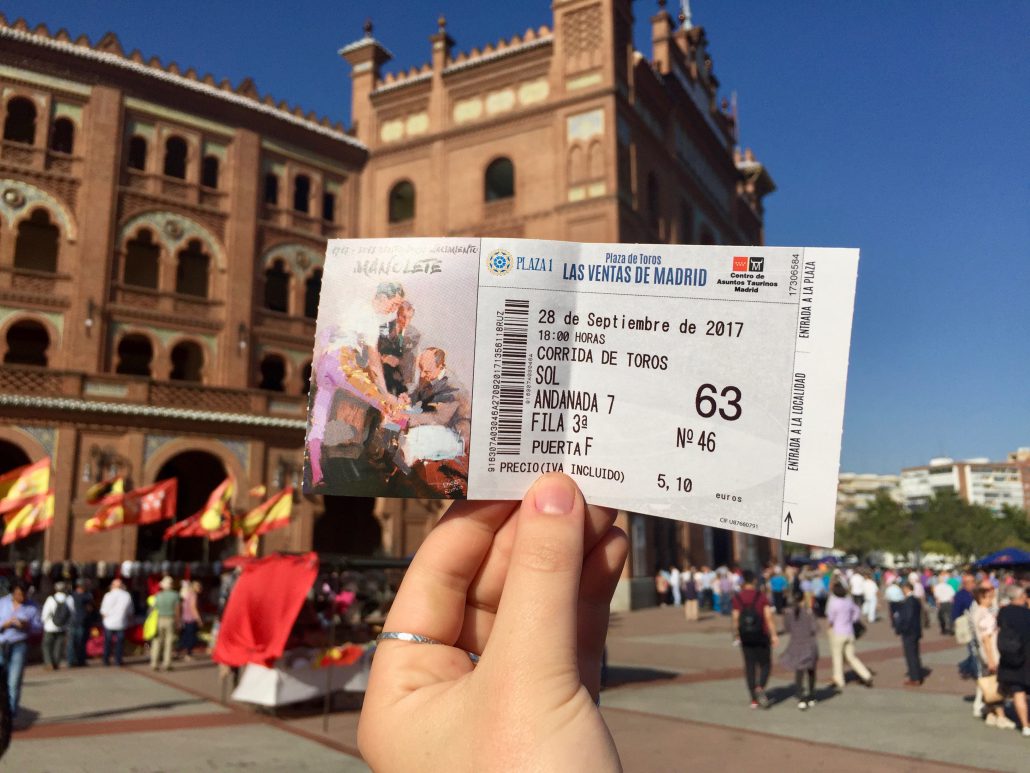
A Brief History
Bullfighting in Spain has origins as early as 711 AD, when a bullfight took place to honor King Alfonso VIII. The bullfight at the time was not the same one that takes place in Spain today, as the fight was reserved for selected members of the Spanish aristocracy / nobility and took place exclusively on horseback rather than on foot. In the early 1700s, King Philip V prohibited nobles from taking part in bullfighting, as he believed it created a “bad image” in front of the common people. Despite this ban, commoners continued to practice the sport on foot. Almost a century later, the present version of Spanish-style bullfighting was introduced by Franciso Roméro in Ronda, Spain at the beginning of the 19th century.
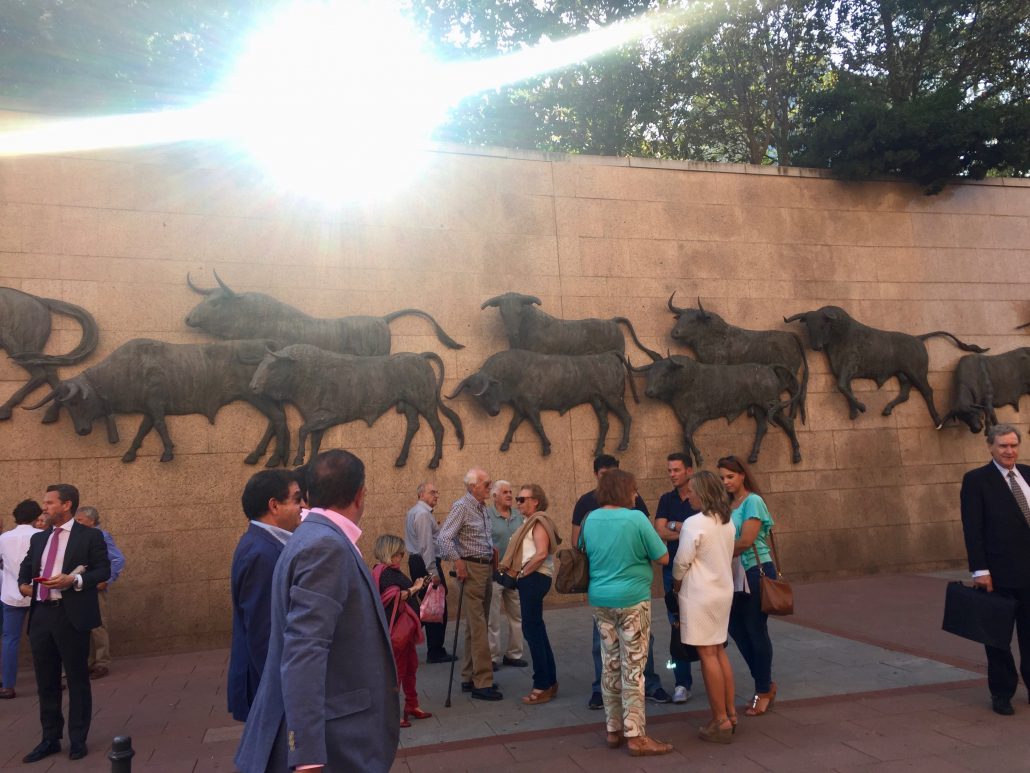

The 3 Stages and Roles of the Fight
The entire event lasts for around 2 hours, including an opening ceremony and 6 separate bullfights. Each matadero (bullfighter) has 6 assistants who make up a caudrilla (entourage), and each group fights two bulls by the end of the night. The separate fights are broken up into three stages, each of which makes it easier for the matadero to kill the bull. The entourage knows when to transition from one stage to the other by the sound of a bugle that rings throughout the stadium.
Once the bull * is released into the ring, the banderillos and matadero test out the ferocity of the animal in the first third by teasing it with the capote (pink and gold cape). Essentially, a group of men wave their capes to make the bull charge in their direction before hiding behind a small barrier close to the edge of the stadium once the bull gets close enough. The matadero will then test the personality of the bull by making a few passes with his capote.
Next, two picadores (lancers on horseback) come into the arena. They stab the bull in the nape of its neck with a vara de detener (pike) in order to weaken those muscles and draw blood. This step in the process forces the bull to hold its head slightly lower during the following stages, which will ultimately enable the matadero to kill the bull cleanly during the third stage of the fight.
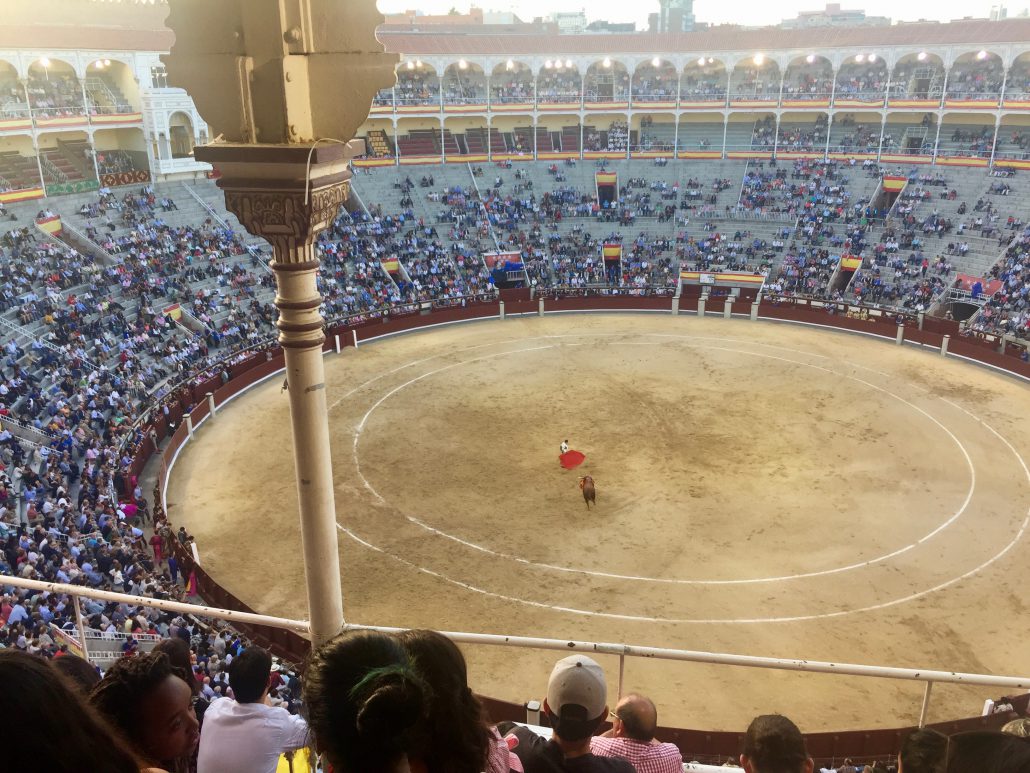
* The Spanish Fighting Bull is a special breed of bull known for its combination of aggression, energy, strength, and stamina. They are bred in large ranches in conditions as close to how they would live in the wild as possible. Since they typically reach maturity later than breeds of cow used for meat due to their muscular physique, bulls used in the fight are 4 – 6 years old. (Remember that these bulls are a special breed — this fact is used by many to justify the fight).
In the second third, each of the three bandilleros (men with colorfully decorated and short darts) stick two banderillas (the darts) in between the bull’s shoulders. This third further agitates, angers, and weakens the bull.

The final stage is a standoff between the bull and the matadero armed with a muleta (red cape) and espada * (sword). The bullfighter draws in the animal with his cape, trying to get as close to the bull as possible while guiding it around him. This ritual continues to tire out the bull and is considered the primary art form of bullfighting, as many claim that the movement of the bullfighter coupled with the danger of proximity between the two subjects shows the intimate relationship between human and beast. Ultimately, the matadero tries to maneuver the bull into a position where he can (ideally) cleanly stab the bull through the shoulder blades and into through the aorta and the heart for a quick death.
* The bullfighter originally starts with a wooden sword, since it is light and easy to maneuver, and then switches it out (with the help of his mozo de espadas, or sword page) for a real blade once he is ready to end the fight.
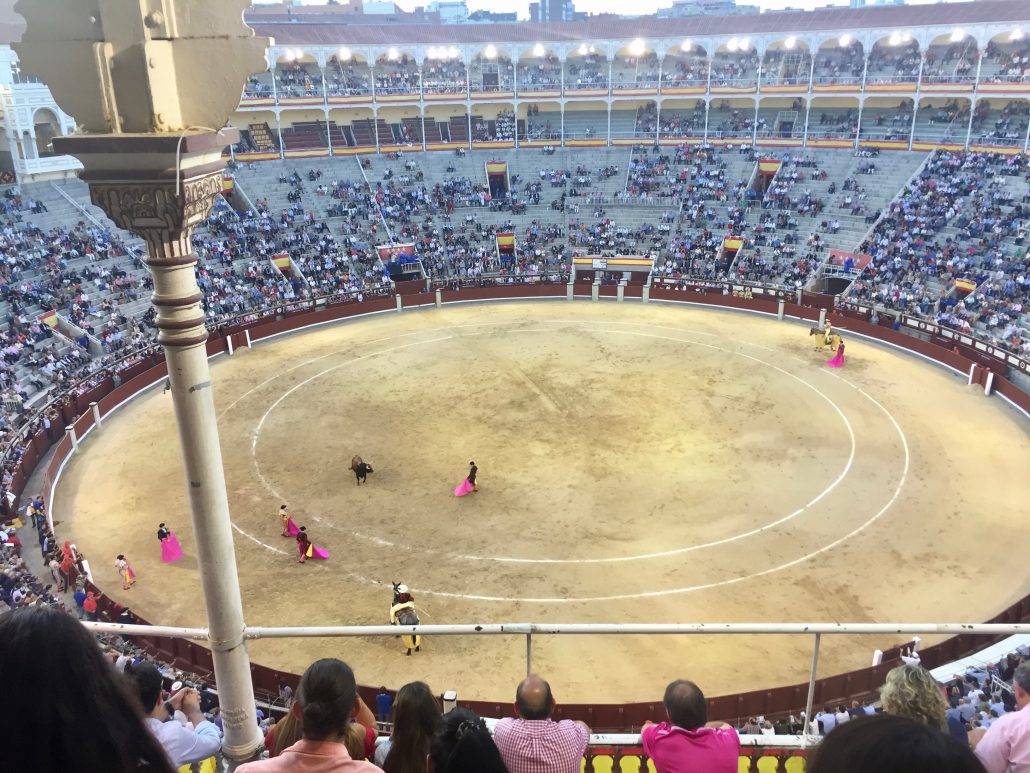
Closing Ceremony
After the death of the bull, three horses bring the corpse around the perimeter of the stadium towards the exit, and the sand is prepared for the next match.
Rituals & Prizes
Sometimes, although very rarely (especially in Madrid, since the stadium is one of the most prestigious out of the the four stable rings in Madrid, Sevilla, Granada, and Aranjuez), a bullfighter performs extremely well (see: has good technique, cleanly kills the bull) and is rewarded with either one ear, two ears, or two ears and the tail of the bull. Even more rarely, the matador will be carried out of the stadium by the crowd. Receiving any of these prizes is a high honor, and is ultimately decided by the president and the spectators.
At the end of a fight, if a matadero performs particularly well, supporters will stand up and wave white handkerchiefs to signal to the president that they think the fighter deserves a prize. The president takes this into consideration and then makes the final decision.
During the fight, there are also certain signs of approval or disapproval from the crowd. The way a spectator claps/whistles for the matadero determines their mood. Claps of approval are normally quicker and shorter, while claps of disapproval have longer pauses in between and sound more hollow. From my experience, the latter form of clapping occurs if:
Overall, angry claps/whistles condemn sloppy or improper technique of the matadero and his entourage.
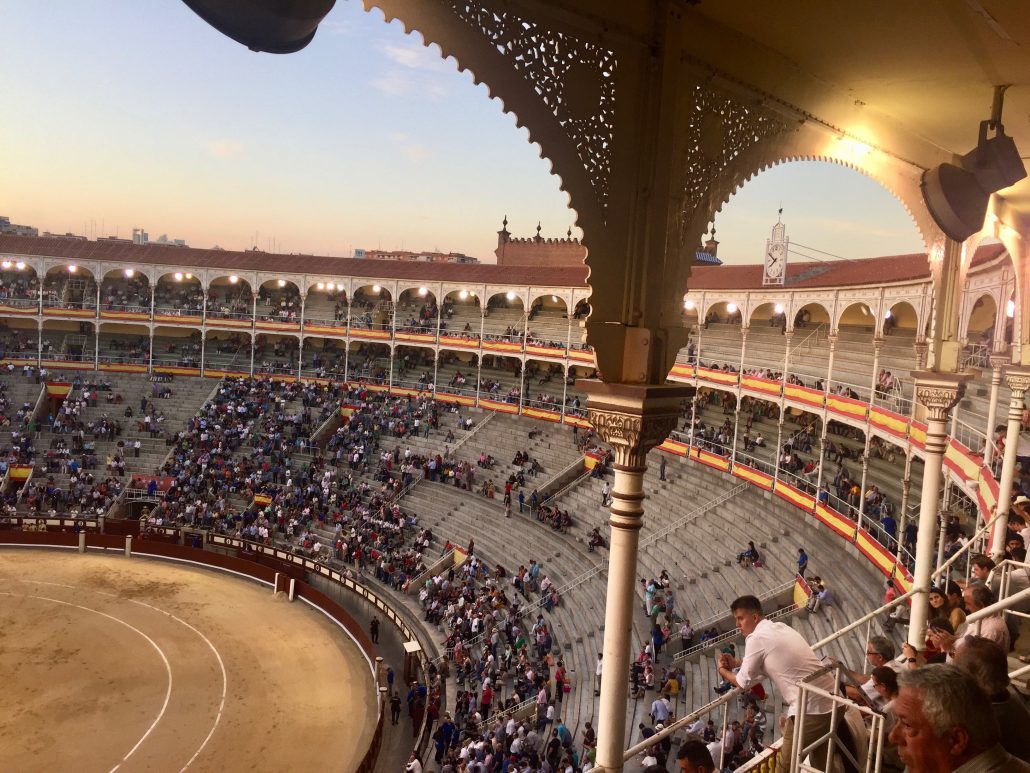
Reflections
Before September 28, I never saw man kill an animal with my own eyes. We were forewarned that six bulls would die during the fight, but hearing about it and seeing it are two completely things.
Watching the first bull fight was especially horrifying, especially since I did not expect poor technique from the matadero.
The bull ran out into the center of the ring at full speed, immediately chasing the first capote it saw until the cape suddenly disappeared behind a wall. Confused, the bull wandered until it saw another capote and ran after that one, just to have the same happen as the man ran behind the wooden shield. Sometimes, the bulls were smart and tried to get around the wall to pursue the moving object, but their horns were too wide to fit in between the crevice of the guard and the wall. I could only imagine the bull’s frustration when it thought the target was within reach, then suddenly disappeared without a trace.
When the picadores came out with their pikes and stabbed the bull in the nape of its neck, most bulls rammed straight into the horses that the picadores were riding. After some seconds of struggle, they would wait for the man to remove the pike and run towards the next cape they saw. After the hit, you could clearly see the blood matting the bull’s skin, even from the top levels of the arena.
The insertion of the six decorated darts by the bandilleros thankfully was over with quicker than the hits on horseback. By this point, though, you could see the bull obviously breathing harder, its stomach heaving with every breath. It was struggling but persevering to fight nonetheless. At this point I realized how majestic this animal was. To endure such pain showed its strength, its personality, its desire to live.
The final third, with just the matadero and the bull was the most problematic for me. This third is also the third that is most important for the matadero score-wise. It does not matter how bad his technique or the technique of his team is up until this third. If he doesn’t show mastery in the final third, there is no chance of acquiring the coveted prize of the ear.
The relationship between the matadero and the bull in the final third was described to me beforehand as an art, not also because of the elegant movement of the bullfighter, but also because of how man could control beast in this section. The closer the proximity between the fighter and the animal, the higher the stakes, the higher the appeal, the higher the artistic value.
I acknowledge that there are some artistic characteristics in the movement of the matadero, since he moves as if he were the lead in a dance and the bull his partner. It does seem elegant, and if the bullfight solely consisted of the part where the fighter and the bull dance with each other, I would likely hold different opinions. The problem, for me, comes from the attitude of the bullfighter.
If he controls the movements of the bull well enough to warrant loud “Olé”s from the crowd, the matador presents himself very pompously. He approaches the bull slowly and tauntingly, arching his back and leading with the muleta. In a series of movements that may be best described as erotic, the matador exposes himself in front of the bull, flirting with the idea of death and asserting his dominance over the animal at the same time.
Some people call this a display of courage. They point to this third when they describe bullfighting as an art. They savor the omnipresent danger that exists in the possibility that the bull may gore the bullfighter at any moment.
Personally, I see bullfighting as man’s attempt to control, manipulate, and assert his dominance over nature. The human race is by no means the strongest out of all the creatures that exist in the world. But as intellectual beings, we’ve built up an idea of superiority in our minds. Man is superior to all other things. Man is capable of thought, therefore man is in charge of the world. All things on Earth and beyond should bow to man, for man is supreme.
Through the matador‘s pompous approach to teasing the bull, we see this ideal of superiority shine through. But even in the context of bullfighting, our assertion of dominance is a hoax. Without the first two thirds of the bullfight, there is no way the matadero would stand a chance against the majestic creature before him. Only after sufficiently weakening and tiring out the bull does he stand any possibility of winning. And when this chance is given to him, he taunts the bull like an arrogant school-kid.
Under different circumstances, man is not more powerful than beast. And for this reason, bullfighting is a pure manipulation of nature to perpetuate our dominance over Earth and its creatures. It may be the largest display of ego I have ever experienced in my almost 20 years in the world.
…
You may have noticed that I use the term “bullfight” often without any qualifiers. Should I call it “the art of bullfighting” when the artistic bit of the whole spectacle serves to bolster our egos and our perceptions of dominance? Should I call it “the sport of bullfighting” when the competition is unfair and the trophy is death?
I’ve been struggling to find some appreciation for the cultural importance of the bullfight for Spain. A country’s culture should reflect the values of its people — I do not think that the values of modern Spaniards at all match those exhibited in the fight.
The most grotesque display of power comes at the end, when it is time for the matadero to stab his sword straight through the bull’s heart. If done properly, the bull should die in seconds. However, this is rarely done as it is intended to be, and the animal can suffer for minutes more, having to endure undue stress in the last moments of its life. During the entire process, the matadero stands proudly in front of the bull with his arm up, as if paying his final respects. He did it. He challenged nature, and he won.
…
I went to the bullfight because I was intrigued. I stayed through the whole thing to try to grasp a deeper understanding of the tradition and the culture. By the end, I was focusing solely on the technique of the matadero, hoping that he would have proper form and avoid causing the bull any more suffering than it had to endure.
I saw 6 bulls die on September 28 and I know many more have died on the same sand. Supporters of the bullfight see the death as a rite of passage. Since the Spanish Fighting Bull is a special breed of bull, supporters argue that this species would die out if it were not for the bullfight. I wonder, though, if 4-6 years of a “good life” is worth the 20 minutes of exhaustion, spectacle, and pain of the bullfight. For me, it’s definitely not. By keeping this breed alive, we are fighting against the natural order of the world. Death is bound to happen, but bullfighting glorifies death at the expense of nature.
If nothing else, the experience provoked some interesting thoughts:
I don’t regret going, yet the lives of those six bulls burden my conscious. I wonder when the eradication of the bullfight as it exists today will come and how the views of the world will be different when it does.
Nos vemos pronto,
(We’ll see each other soon)
Nina
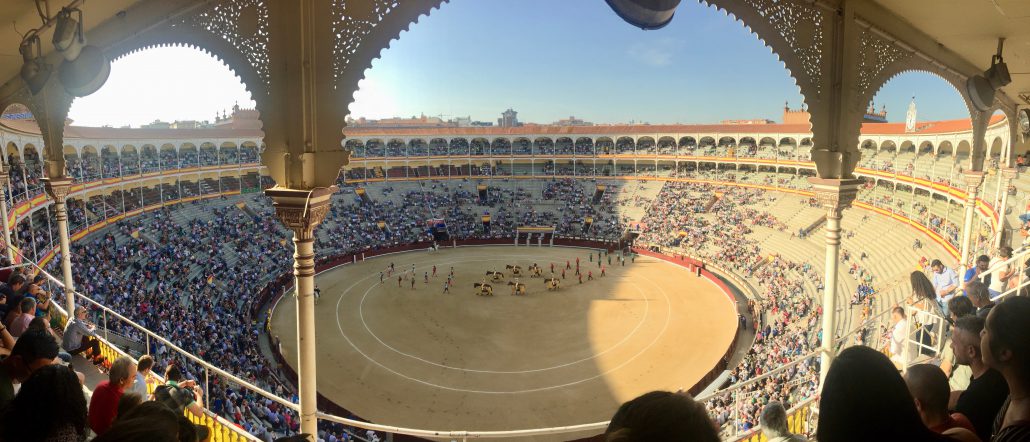
Nina Chikanov studied abroad in Madrid, Spain in fall 2017: http://eap.ucop.edu/OurPrograms/spain/Pages/contemporary_spain_madrid.aspx
BY SHERRY WANG
LA’s traffic is notorious—going east to west or vice versa can take an hour. Since my hometown is roughly three hours away from UCLA in morning traffic, I wasn’t exactly eager to drive there for the first two weeks of class.

Lucky for me, the International Business Law & Taxation program offers an online real-time class option for the first two weeks of the program. Last Tuesday, I found myself rolling out of bed at 8 a.m. to attend the first class right at home. With participation counting as 30% of the overall grade, students joining the lecture online are expected to contribute as much as the students in the classroom.
Students who are unable to attend the real-time options – online or in the classroom – can watch a recording of the lecture on their own time. In that case, students must complete an additional assignment to demonstrate their class participation. Given the options, the first two weeks of the program allow you to attend in class no matter where you are in the world!
Like most other video chat technology, the one Professor Freixes uses allows students at home to see and hear him, his powerpoint, and all the other students online. Professor Freixes and the students in the classroom can see and hear everyone online. This way, it is easy for everyone to participate.

I found myself more engaged in this online style of learning than in learning in a live classroom. Furthermore, the Professor often discussed current events and encouraged students to look up information on their own laptops/phones in class.
Like with most 3-hour summer classes, our class got a 15-minute break, during which I turned off my laptop camera and wandered into my kitchen to grab a drink and snack. Super cool and convenient. Of course, if you live close to UCLA or are on campus, attending the class at UCLA has its own advantages. For example, it serves as an opportunity to meet other students and the professor.
I encourage those who decide to enroll in the program to reach out to the students on the Facebook group prior to the start of the program. It’s a great way to meet students to travel with, study with, or even share books with. Understanding what others are doing in terms of travel, packing, and textbooks can be extremely helpful for your own preparations.
A few months prior to the program, I reached out to some fellow travelers, met up at a dining hall, and started getting excited for all the adventures we were about the have abroad. Later on, I found another student to share textbooks with (ebooks are the way to go!). I couldn’t be more pumped for the abroad portion of Travel Study.
Stay tuned!
Sherry
Sherry Wang studied abroad in Paris and Strasbourg, France, in summer 2017: https://ieo.ucla.edu/travelstudy/intlbuslaw/
BY SAVANNAH SHAPIRO
Europe is different than the United States. Very different. There were so many things that I was unaccustomed to that I decided to make a list of what was different here in London as opposed to the United States.
Food
Enjoy your nice cheeseburger and side of ranch dressing because this is something that is hard to come by here in London. And if you do by chance find a cheeseburger here, it’s just not the same. I ordered a salad one night at Montague Pyke, a restaurant near the Soho area, and that was the first time I realized food here was very different. The ranch dressing isn’t our creamy deliciousness but instead it is watered down. It’s more acidic and has a tang at the end that I don’t find appetizing. Cafes line the streets and there are cute bakeries everywhere it’s just a matter of finding the one that’s for you. We have stuck to a diet of pizza and I think that’s the way to go! I’m still on the hunt for my go to restaurant.



AC
There is no AC anywhere here. It can get unbearably hot and humid here in London and all you want to do is sit in a place that has air conditioning, but that is very difficult when restaurants, dorm rooms, stores and transportation systems lack AC. Staying hydrated is key especially in the tube where everyone is packed in like sardines in an underground tunnel!

Ice
Unfortunately, London is short on ice, especially when it’s hot outside. Most restaurants here are accustomed to serving room temperature beverages, making you appreciate the nice cold soda you can get from the U.S. Once we started asking for ice, we were finally able to get the cold drinks we were searching for. I found it really helpful to freeze a bottle of water before our walking tours and long day of class.

Trash Cans
Surprisingly, there are few trashcans that line the street like we are used to. In London, they don’t call trashcans trashcans, but rather they call it litter. If you go to a Starbucks or any other café for that matter, don’t be surprised if there isn’t a trashcan. You can simply leave your trash where you are siting and the staff will clean and remove the trash for you.
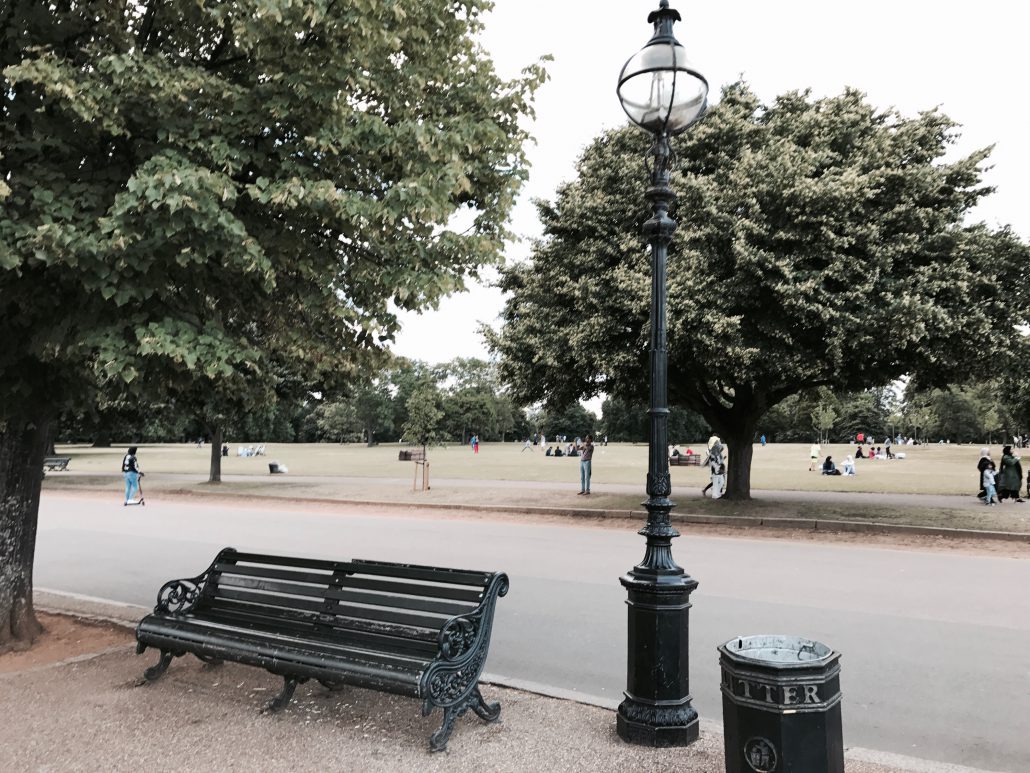
Smoking
In the U.S. there are designated smoking areas, but as for the U.K. there are not. Many people smoke cigarettes in the street which I found to be an interesting difference from the United States.
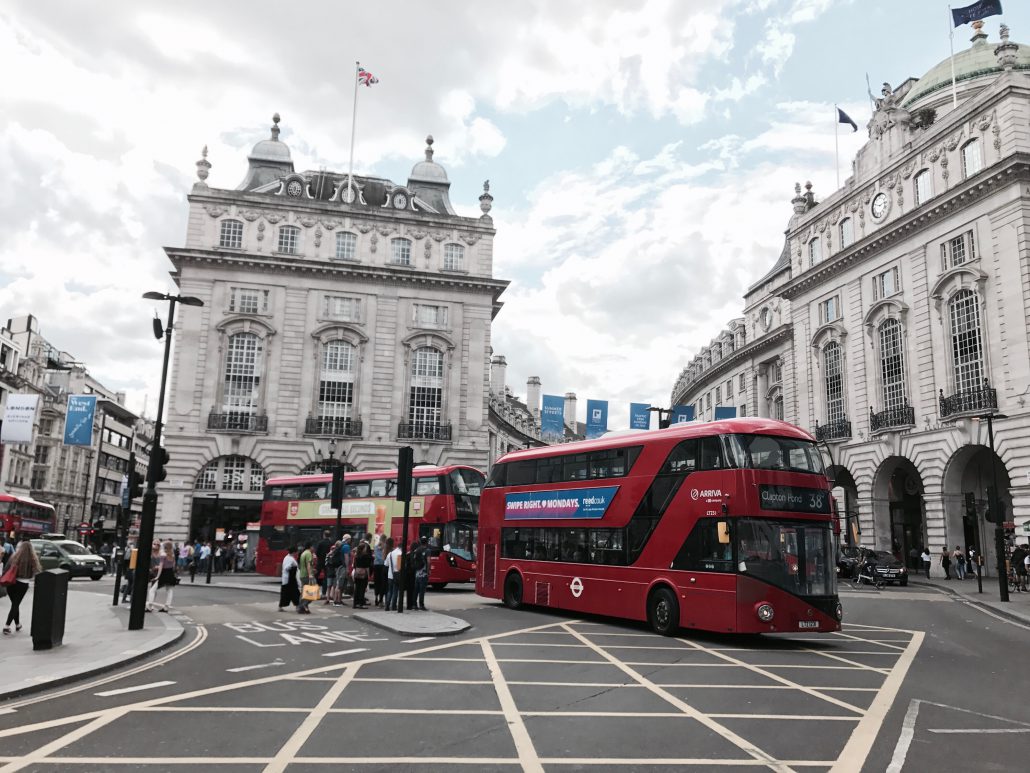
Traffic and Transportation
Double decker buses are so cool here! I loved hoping onto a bus and going up to the second floor. The view is very nice from up there, and taking a ride on the bus is very helpful for understanding the streets of London. A double decker bus is the epitome of London. I didn’t think that the buses could get you from point A to point B, and that they were just tourist attractions, but they are very helpful and get you to your destination very quickly. The buses are also cheaper than the tube.
How to pay at a restaurant
It is a little different here than the U.S. If you use an American debit or credit card, which most people in the program did, the waiter/waitress brings out the ATM pin pad and inserts your chipped card to pay the bill. You pay the bill directly at the table, and are not obligated to pay tip. If you eat with a large group then you may see a service fee added to your bill, which is just the same as gratuity in the U.S. If you want to leave a tip you always can, but it is not mandatory nor do the workers expect it. Also after paying, you must sign the receipt in which they check your license or the back of your card to make sure your signature is the same.
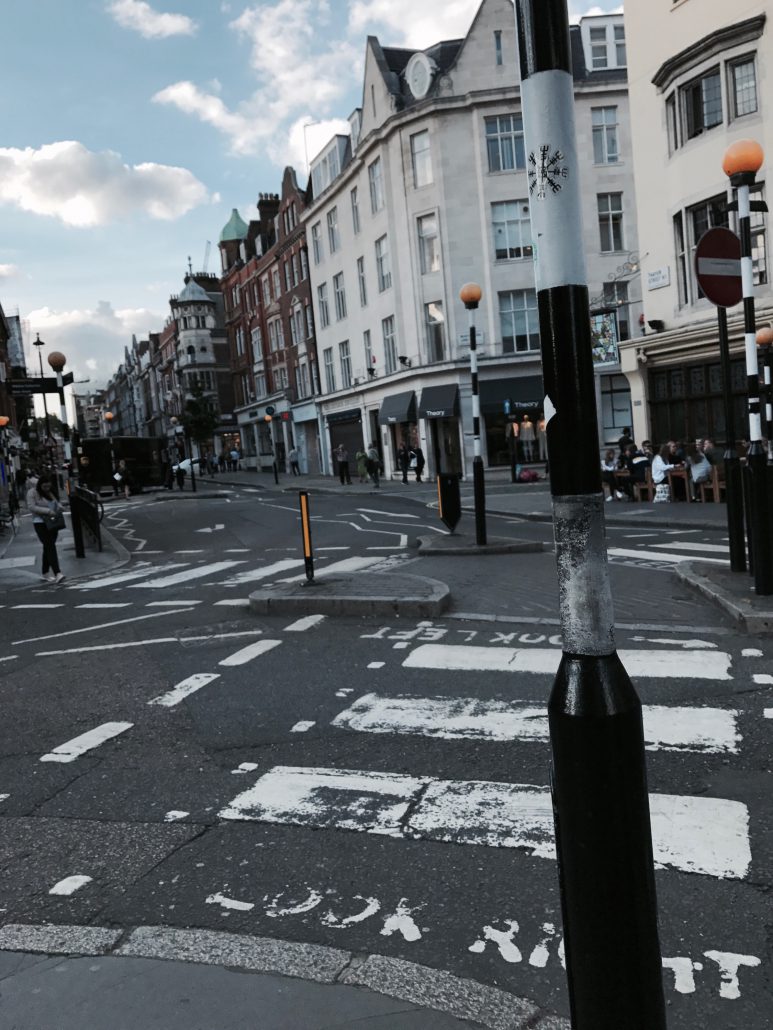
Drving and crossing the street
I’m still trying to understand how the rules on the road work here in London.
Cars are on the opposite side of the street, drivers drive on the opposite side of the car, and when you cross a cross a crosswalk you look left, right, left. Cars usually do not stop because it is not pedestrians right of way like how it is in the U.S. Also, stop lights work a little differently. The light changes from red to yellow, which allows the stopped cars to slowly take off. It is important to make sure you clear the crosswalk in time, before the cars start to take off. Because crossing the street can be a little intimidating at first, make sure to find zebra crosswalks which are indicated by the black and white striped poles that have a large yellow bulb at the top. These crosswalks function as our stop signs which allows the pedestrian the right of way. Cars stop for you, but make sure to look both ways before crossing at all times!

Escalators
Believe it or not there are two lanes to an escalator! Although it’s a normal escalator the crowd divides into two sides: the right side is used for standing, while the left is used for walking. Because there are a lot of commuters who are rushing to get to their destination, it is important to move to the right side if you want to stand. If you are in a rush to catch a train or the tube, it would be best for you to use the left side and walk down or up the escalators with the rest of the rushing commuters!
Gas Stations
You would think that in a packed city with many cars there would be multiple gas stations, but we found it very interesting when we could barely find any. There is a gas station called BP within the city, and the only one we’ve seen by far. Good thing we take those buses!
Toilets
In the U.S. you can use public restrooms practically anywhere you’d like. However, in London, not everywhere restaurant or store has a restroom to use. Some public places that do have toilets require you to pay to get in. I suggest to ask a restaurant kindly if they have a restroom, which they actually refer to as toilets, and they will more often than not allow you to use their restroom.
Savannah Shapiro studied abroad in London, England in summer 2017: https://ieo.ucla.edu/travelstudy/English-London/
